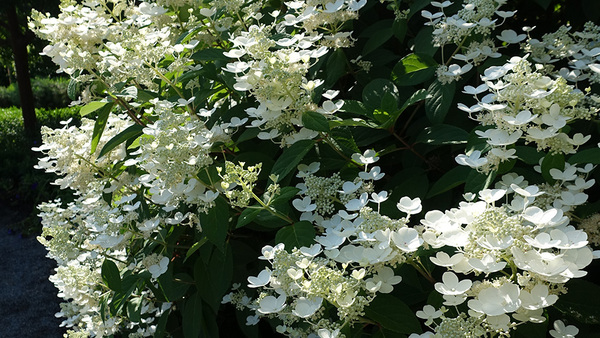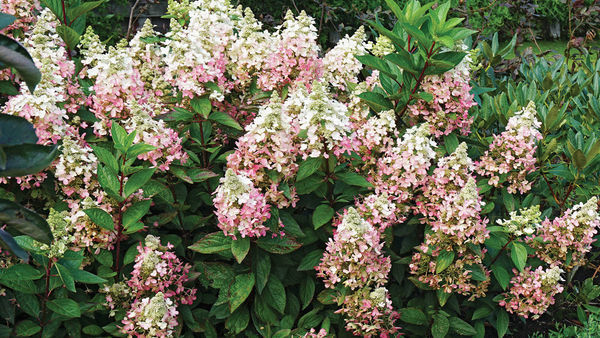
Hydrangeas (Hydrangea spp. and cvs., Zones 4–10) seem to be a necessary part of every Southern garden. Those big, billowy blue flowers under tall trees in shady gardens look cool even when the temperature is in the nineties. Since living in the Southeast practically requires you to plant a hydrangea, we are listing a few of the best that have proved to shine in our region. There is no empirical data to go with these choices, just opinion and experience.
‘Dooley’ bigleaf hydrangea offers reliable blooms and mildew resistance
One of the best big blue bigleaf hydrangeas is ‘Dooley’ (Hydrangea macrophylla ‘Dooley’, Zones 6–9). A good-size shrub up to 6 feet in height, it makes big blousy heads of flowers. It blooms reliably because it sets flower buds on both old and new wood. This is important in our part of the South because of warm snaps of 80-degree days followed by hard freezes in the low 20s. We’ve found ‘Dooley’ to also be more resistant to mildew than other bigleaf hydrangeas in our garden. It grows best in a mixture of morning sun and afternoon shade.
‘Madame Emile Mouillere’ bigleaf hydrangea produces stunning white blooms

Another great bigleaf hydrangea is ‘Madame Emile Mouillere’ (Hydrangea macrophylla ‘Madame Emile Mouillere’, Zones 5–9), an old French selection with big white blooms. The individual bracts are often serrated along the edge, making the blooms even lacier. As the flowers age they often become a very pale shade of blue. This cultivar also grows up to 6 feet tall and sets flower buds on old and new wood. This means if a late hard freeze does away with the first round of flowers, there is a later bloom to come. It grows best in a mixture of morning sun and afternoon shade.
BloomStruck® bigleaf hydrangea has a smaller form with uniquely colored flowers

BloomStruck® bigleaf hydrangea (Hydrangea macrophylla ‘PIIHM-II’, Zones 4–9) is part of the Endless Summer® line of hydrangeas. The shrub is a bit smaller than most bigleaf hydrangeas, staying in the 3- to 4-foot range. Flowerheads cover the plant for most of the summer. The best thing about BloomStruck® is its colors. The flowers are mostly lavender purple, but there are some green edges, pink bracts, blue bracts, and lime-green bracts also mixed in as the flowers age. It grows best in a mix of morning sun and afternoon shade.
‘Snowflake’ oakleaf hydrangea is a showy native

Oakleaf hydrangeas (Hydrangea quercifolia and cvs., Zones 5–9) are native here. They like filtered sun and well-drained, moist soil. One of the showiest of all is a variety called ‘Snowflake’ (Hydrangea quercifolia ‘Snowflake’), which was originally introduced by Aldridge Nursery. The white conical heads are made up of stacked bracts, so the “flowers” appear double. Generally reaching 6 to 8 feet in height, they hold their heads up high.
‘Blue Wave’ bigleaf hydrangea is a knockout with lacecap flowers

‘Blue Wave’ hydrangea (Hydrangea macrophylla ‘Blue Wave’, syn. Hydrangea macrophylla ‘Mariesii Perfecta’, Zones 5–9) likes morning sun and afternoon shade to achieve its best color. This old bigleaf hydrangea has fertile flowers mixed into the sterile bract flowers, so instead of a big ball of flower it is a lacecap. The flattened lacey flowers are an incredible brilliant blue in our low pH soils. The shrub is 5 to 6 feet tall and wide. Unfortunately, the flowers only form on old wood, so a sheltered spot in the garden helps ensure yearly flowers.
‘Annabelle’ smooth hydrangea is a great performer in low light or hot afternoon sun

‘Annabelle’ smooth hydrangea (Hydrangea arborescens ‘Annabelle’, Zones 4–9) may be the most versatile of them all. Both the ‘Annabelle’ hydrangea on the north side of our house (which receives no direct sun) and the one on the west side of the house (which receives hot afternoon sun) bloom well and abundantly. This selection grows to about 5 feet tall and reliably produces big, round balls of pure white flowers that are held at the top of the foliage, making them particularly showy. This is also a native plant.
Bobo® panicle hydrangea shines with white fluffy flowers on short sturdy stems

Our final favorite is Bobo® panicle hydrangea (Hydrangea paniculata ‘ILVOBO’, Zones 3–8). This hydrangea prefers full sun to partial shade and blooms best if it gets at least five or six hours of direct sun. It’s a great hydrangea for its huge cones of extra fluffy white flowers that are produced on new growth (so no worries about losing blooms to freezes or pruning). The flowers are held at the top of the foliage at the end of the shorter sturdier stems—usually 4 to 5 feet in height.
Every garden needs a hydrangea, and there is likely one that will suit your garden. Probably there are several that will suit your garden. Be careful, or you’ll end up with a collection.
—Jason and Shelley Powell own and manage Petals from the Past, a garden center in Jemison, Alabama.

















Comments
Log in or create an account to post a comment.
Sign up Log in